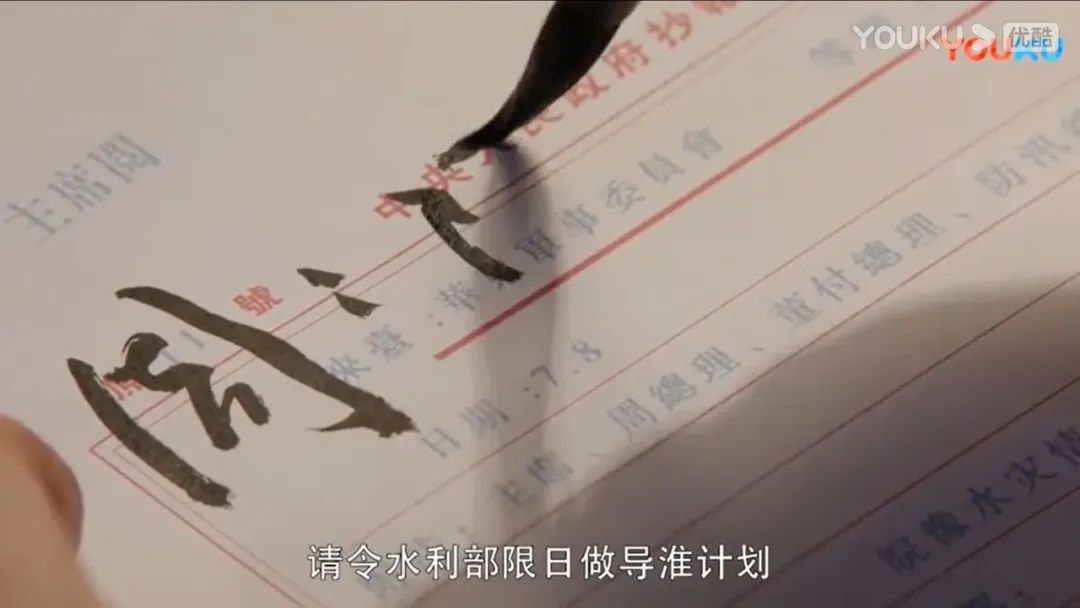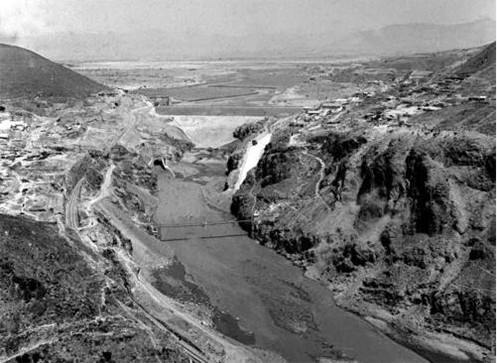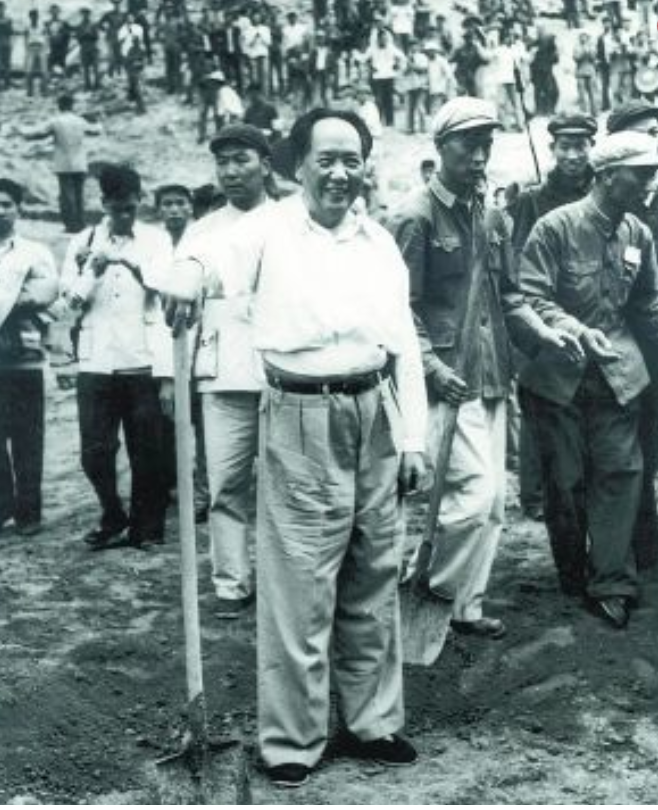In the 1950s, why was reservoir all over the country?
Author:Look at the think tank Time:2022.09.23


China has established the country since ancient times, so the treatment of water in the dynasty has been a top priority.
However, in modern times, the war has been frequent, the economy has withered, and the national crisis has been deep. Whether in the late Qing Dynasty or the Republic of China government, neither financial and energy controlled. Disaster, light rain and small disasters, no rain and drought. "
With this as the background, after the founding of the People's Republic of China, the road to water treatment started difficult.
Text | Tomato Sauce
This article is reproduced from the WeChat public account "National Human History" (ID: GJRWLS). View.
1
Water is fierce than tiger
At the beginning of the founding of New China, two major floods were encountered.
The first was in the Huaihe River. In the summer of 1950, the Huaihe River Basin was first long drought without rain. It was influenced by the warm and humid airflow of the southwest. The three consecutive rainstorms were reduced. The affected area of the entire basin reached 4687 acres, more than 13 million victims, and more than 890,000 houses collapsed.
The most important thing in the northern Anhui region of the middle and lower reaches. At that time, Zeng Xisheng, Secretary of the Party Committee of the Northern Anhui District of the Communist Party of China, issued a telegram to the East China Bureau and the Central Committee: "This year, the water situation is large, and the tragedy of the affectedness is not only more important than last year, but also unprecedented for a century ... Many of them are sinking in the village. Cow and agricultural tools are extremely loser. Due to the fierce water, the masses are too late to escape, or climb the trees, lose their footsteps (have a poisonous snake bite on the tree), or the small waves of the boat, the boat turn over the boat ... He cried, and the cadres shed tears. "

In the film and television drama, the Huaihe River was affected in 1950. Source/TV series "Change the World" screenshot
Zeng Shan, then a government member, saw that the Huaihe River saw: "There is a piece of ocean on both sides of the Jinpu Railway, all dozens of miles. The river embankments along the road have lost their effects. Can't see it, many victims squeezed on high grounds to survive. "
The other occurred in the middle and lower reaches of the Yangtze River. In 1954, from April to late August, the heavy rain in most parts of Hubei province continued, which led to the surge in the water level and the full lake, which caused the unparalleled flood disasters for hundreds of years.
Although the flood was built before the Jingjiang flood division project and successfully defended the Jingjiang embankment and Wuhan City, it still caused serious disasters to the middle and lower reaches of provinces. sky. Taking Chongyang County in Xiaogan Zone as an example, the rainstorm triggered mountain floods. 70%to 90%of houses in 64 townships in the county were broken. There were only 3 houses left in 306 households in Xiajin Xiaxian Township. The village was all glowed. There were more than 700 people in Hongxia Village who were trapped in the mountains for two days without food.
The water and fire were ruthless, and the raging floods were destroyed and the new people's regime was tested.
After receiving the telegram of the Huaihe River disaster, Mao Zedong shed tears. He wrote a criticism of the Prime Minister of the Political Affairs Council: "Zhou: Please make the Ministry of Water Resources to make a plan to guide Huai and send me a reading. This plan must be done in August and passed by the government officer. manage."

In the film and television drama, Chairman Mao made a approval. Source/TV series "Change the World" screenshot
From late August 1950 to mid -September, the central government held a meeting of Huaihuai in Beijing, decided to use "storage and raising" as the policy of governance and determine the upstream "to stop the flood development of water conservancy as the long -term goal". Open into the seawater. The first large -scale water conservancy project "Governance" project in New China kicked off.
2
Construction reservoir
According to the "storage and preparation" policy, the upper reaches of the Huaihe River is mainly to build a reservoir.
From 1950 to 1957, Henan Province on the upper reaches of the Huaihe River successively built five large reservoirs such as Shiman Beach, Baisha, Banqiao, Booshan, and Nanwan.
The Shiman Beach Reservoir started in 1951 and was completed that year. It took only 3 months, and the water storage capacity was 47 million cubic meters. Although the library capacity is not large, it has different significance. It is the first reservoir built by the Huaihe River Basin after the founding of New China, and it is also the first reservoir we built by our own strength. In addition to the flood control function, the completion of the reservoir can also irrigate 90,000 acres of farmland. At that time, people evaluated it as "my country's water conservancy cause from removing harm to Xingli, from simple flood prevention to a turning point in the development of multi -target projects that take into account flood prevention, irrigation, shipping, and power generation."
The official hall reservoir started later at Shiman Beach has these functions.
The official hall reservoir is located on the Yongding River. The Yongding River is the longest and most difficult river in the five rivers of the Shanghai River System of the North China Plain. The three tributaries of the Sangan River, Yanghe, and Luohe in the upper reaches flowing into the official hall of the official hall of Huailai County. Its riverbed is more than ten meters higher than Beijing. In the past, the floods of the mountains and floods were often caused by huge disasters. Yuan, Ming, and Qing dynasties have tried to govern the Yongding River, but they all had little effect.
During the Republic of China, the flood invaded the city of Tianjin twice, and the victims escaped on the street.
In November 1949, the Ministry of Water Conservancy held a joint meeting of the water conservancy area on the liberated areas, and decided to build three reservoirs in the upper reaches of the Yongding River, the middle reaches of the stone box, the official hall, and Ma Gongzhuang, and first built the government hall reservoir. In October 1951, the project started. According to the plan, the dam was built at the gorge, the dam is about 50 meters high, the reservoir area is 220 square kilometers, and the water can be stored 2.2 billion cubic meters. This capacity was 44 times that of the Shiman Beach Reservoir, ranking first among all reservoirs in the country at that time. In the summer of 1953, the reservoir in the construction was also ushered in a big test. At that time, due to the heavy rain in the Sanggan River Basin, the upper reaches of the Yongding River soared, and the flood flowing into the reservoir of the official hall was about 450 million cubic meters. In the end, the government hall reservoir also handed over the perfect answer sheet. The turbulent floods slowly flowed out of the water tunnel. The flood disasters of the downstream people were greatly reduced, and the Beijing -Tianjin Railway was also unobstructed.
In May 1954, all the reservoirs of the official hall were completed. When inspecting the construction site, Mao Zedong wrote his inscription: "Celebrate the victory of the government hall's reservoir project." Water storage in the warehouse can be used to provide urban water, industrial water, power generation, and irrigation farmland. It can also adjust the downstream traffic of the Yongding River to facilitate shipping.
On May 13, 1954, the builders of the government hall reservoir held a grand project to celebrate the celebration. Source/Beijing Daily

Different regions, the main functions of the reservoir are also different. Like the Zhongxiang Shimen, Hubei built in 1954, the reservoir and other reservoirs such as Suizhou Black House Bay, Hubei built in 1956 are mainly irrigation. , Jiangxi Shangshangjanjiang Hydropower Station, built in 1955, and Sanmenxia Water Conservancy Hub started in 1957, mainly generating power generation; the Hunhe people's houses built in 1954, and Miyun, which were built in 1958, mainly carried urban water supply functions.
Most of the above reservoirs were completed or started during the "Five-Year Plan" (1953-1957). After 1958, the momentum of building a reservoir remained unabated. From 1958 to 1963, a total of 23 large reservoirs, 47 medium -sized reservoirs, and a large number of small reservoirs were started at the same time. In the same period, Hunan Province also built new cards, Shuifu Temple, Jiubu River, Jiubu River, and Jiubu River in 5 years. Yellow material, yellow stone, Wangjia factory, Guanzhuang 7 large reservoirs, 69 medium -sized reservoirs, and more than 5,700 small reservoirs.
All in all, throughout the 1950s, New China built a reservoir from south to north, from east to west. In the first 40 years after the founding of the People's Republic of China, there were more than 86,000 large, medium and small reservoirs, with a total library capacity of about 450 billion cubic meters. The 355 large reservoirs and more than 2400 medium -sized reservoirs played an important role. The Sanmenxia, Liujiaxia, and Longyangxia Reservoir, such as the dry flow of the Yellow River, control the main flood sources of the Yellow River. The reservoirs of the Haiyu River, Liaohe, Huaihe, Han River, and Dongjiang River control most of the water collection area between hills.
On May 13, 1954, China's first large valley reservoir -the official hall reservoir was completed at the junction of Beijing and Hebei. The picture shows the panoramic view of the government hall reservoir. Source/Beijing Daily

As far as the water treatment itself is concerned, this is a systematic engineering with a long investment, labor -intensive and construction cycle. But how did the new China, the first one of the first, the first one, and the one -hundred -hundred and hundreds of reservoirs were built?
3
Mobilize
In the face of difficulties, governments at all levels of New China have continued to follow the effective mobilization mechanism, fully mobilize the people from all walks of life, rely on farmers who rely on the masters, party and government cadres who have been exercised by war, intellectuals who are willing to dedicate, and participating troops. Insufficient material conditions.
Take the five reservoirs on the upper reaches of the Huaihe River built earlier as an example. At most, the Shiman Beach Reservoir used 40,000 people. The Banqiao Reservoir was 85,000, the Baisha Reservoir was 100,000, and the Nanwan Reservoir was 83,000. There are 45,000 landscapes. These five reservoirs are all soil dams. Therefore, artificially is mainly worn during construction. Dams are mainly pushed by people to push small cars or lift them. Only sheep crushed and bulldozers are used when crushing.
Such a huge construction team is mainly composed of farmers and the PLA water conservancy engineering forces. At that time, the conditions were very difficult, and the builders lived in the sheds and ate openness. The salary of migrant workers is generally low, with obligations of labor. However, most of them come from the beneficiary areas of the reservoir. The construction of the reservoir is regarded as the construction of their own home.
Of course, in terms of the number of participants, the largest and most political significance is the construction of the Shisanling Reservoir. A total of 400,000 people have participated in the construction of the reservoir.
The Shisanling Reservoir is located in Changping District, Beijing. Compared with other reservoirs, it has two special features: one is to break the conventional construction model, survey, side design, and side construction; the other is to build it under the direct leadership of the Party Central Committee.
On January 21, 1958, it was frozen in the cold, and Shisanling Reservoir held a starting ceremony at the hillside at the time of Dongshankou. Eight thousand labor troops, carrying luggage on their shoulders, with food and cooking utensils to the construction site. However, while lack of construction machinery, although the workers are very enthusiastic, they are almost unlikely to complete the dam -building task before the flood season. The Beijing Municipal Party Committee decided to mobilize the city's workers, peasants, and business soldiers to participate in obligations. The leaders of the central and state organs and international friends and staff of some foreign embassies in China also took the cold to participate in labor in the reservoir.
On May 25, the then party and state leaders Mao Zedong, Liu Shaoqi, Zhou Enlai, Zhu De, and Deng Xiaoping led all the central members of the Second Session of the Eighth Session of the Party to the Thirteen Tomb Reservoir to participate in obligations. Soon, Zhou Enlai led more than 300 cadres of the State Council and the Central Organs to the reservoir for the second time to participate in labor.
Mao Zedong, who participated in the obligations of the Thirteen Tomb Reservoir. Source/People's Network

At that time, the construction site was not intermittent almost 24 hours. During the day, the red flag fluttered, and the singing was burst; at night, the lights were bright, and the valleys looked like daytime. It is in this strong atmosphere of the whole people that most reservoir construction in New China was often very fast. The time used for less than a few months, and more generally 1-2 years. The slow rhythm of survey and construction in several years.
More importantly, not only has the speed, but also the quality is pretty strong.
When building the Nanwan Reservoir, due to the few drilling holes during the survey, the geological staff requested that the geological situation could not be found to be able to build it. Cadres and soldiers do not understand technology and do not understand. Geological officers come to Beijing to bring the book of the US dams to the United States Dam to listen to everyone, making people realize the importance of quality problems. As a result, the project stopped for half a year and re -launched geological exploration. Because of this, the Nanwan Reservoir was tested in the Great flood in August 1975.
There are also many reservoirs, which are lacking in hydrological materials such as floods and earthquakes at that time, and there are general problems with low design standards. Like the Shiman Beach Reservoir, in the flood in 1975, because the flood peak flow exceeds 4 times the design standards, it leads to the dam burst. The Foziling Reservoir, which was completed in 1954, also had a drum accident during the same problem in 1969.
Compared with medium and large reservoirs, the number of small reservoirs organized by the people by themselves. In 1952, there were 3.14 million new small reservoirs and small channels across the country, while the water conservancy army of 2,000 people in a commune of Pujiang County, Zhejiang had completed a 700,000 cubic meter of reservoir in 4 days. According to incomplete statistics, from 1950-1952, about 20 million people directly participated in the water conservancy construction project. The completion of the earthwork was equivalent to tapping 10 Panama Canal or 23 Suez Canal. In fact, as far as the conditions of New China were concerned, the construction of small and medium -sized water conservancy projects was indeed more realistic.
The active participation of the masses has been supported by the government's strong support.
Three years before the founding of New China, 1.03 billion yuan was invested in agricultural and forestry and water conservancy construction, accounting for 13.14%of the entire basic construction investment in 3 years, most of which were used for water conservancy construction. At that time, it was also facing problems such as clearing the disabled enemy, ensuring the supply of millions of military and political personnel, and disaster relief. Under the pressure of restoring financial tasks, why did the people's government still take out so much money to build water conservancy?
4
For the people
On the eve of the founding of the People's Republic of China, Edison had publicly said: "China's population has doubled in the eighteenth and 19th centuries, so it has become an overwhelming pressure for China. It is to solve the people's eating problems. So far, no government is successful. "
This issue also tests the new people's regime.
In November 1949, the central government emphasized two points in the restoration work: one is transportation, especially the railway; the other is on water conservancy and agriculture. In terms of agriculture, water conservancy is equal to agriculture, and water conservancy must be matched with agriculture. Even words such as "building water conservancy, flood prevention and drought prevention" have been written into the "Common Program of the Chinese People's Political Consultative Conference". At that time, most parts of China had completed land reform, but for the people's government, it was the ultimate goal for the majority of farmers who were divided into land. Therefore, preventing water and construction of water conservancy is the main task of water conservancy construction after the founding of the People's Republic of China, and it is also the basic policy for New China.
From the Huaihe River to the Yangtze River, the Yellow River, to the river and other parts of the country, such as the Haihe and the Liaohe River, the benefits of the construction of a large number of reservoirs are obvious. As far as agriculture is concerned, the irrigation area was increased by more than 49.5 million acres from 1950-1952. The national flood area was rapidly narrowed year by year. In 1949, it was more than 100 million acres, 1950 was about 60 million acres. It is 16 million acres. Like the Guanshi Reservoir, it is only estimated that at least 100 million kilograms of Xiaomi will increase each year.
On the other hand, in the early days of New China, most farmers still faced the pressure of floods. They called on them to participate in the construction of the reservoir, which reduced the difficulty of organizing mobilization. At the same time, many migrant workers participating in the construction were the disaster area victims. The government asked them to participate in labor and adopt " In the way of work, it not only guarantees the government's disaster relief goals, but also prevents the victims from flowing and gathering towards the city.
In 1951, Chairman Mao Zedong issued a call for "must be repaired by the Huaihe River". In May of the same year, the Central Governor Huai Visual Visiting Regiment awarded the banner of Chairman Mao's inscription.

The water conservancy is well -established, the people are determined, and the country is stable. This may be the inherent logic of the construction of a large number of reservoirs at the beginning of the founding of New China. After more than 70 years of baptism, the reservoir built in that year still played an irreplaceable role, and many places even became tourist attractions.
Today, when people enjoy the flow of clearing and enjoying the mountains and rivers, can they imagine the hot spirit and forgetfulness of the older generation of builders on the construction site and whether they can understand the older generation of builders. Reference materials:
1. Wang Ruifang: "History of Contemporary China Water Conservancy", China Social Science Press 2014;
2. Qian Zhengying: China Water Conservancy, 2012 China Water Conservancy Hydropower Publishing House;
3. Gao Jun: "Starting for New China's Water Management (1949-1957)", a doctoral dissertation in Fujian Normal University in 2003;
4. Li Baoxia and Xu Lianying: "Thirteen Tombs Reservoir", "Beijing Archives" No. 4, 2002;
5. Gao Jun: "On the Comprehensive Management of the Huaihe River in the early days of the founding of the founding of the country", "Contemporary China Research" Volume 10, No. 5;
6. Yang Xuexin and Liu Hongsheng: "Zhou Enlai and the Construction of Haihe Water Conservancy in the early days of the founding of the People's Republic of China", "Journal of Hebei University (Philosophy Social Science Edition)" Vol. 38, Issue 1.
Uncle Ku Welfare
Uncle Ku's book is always there! Boji Tianjuan provided Uncle Ku with 20 "Pain" to be given enthusiastic readers. Douban 9.4 -point ultra -high word -of -mouth British drama "Pain is inevitable" original novel! A male doctor who is absolutely ecstatic to be ecstatic! It was burnt and funeral, with an average of 1 smile every 3 sentences, and was deeply cured after laughing. Please comment under the article that the top 3 (more than 50) who likes the highest likes will get a book.


- END -
Involved in the Abe incident, Tangshan Normal University emergency statement!

On July 9, Tangshan Teachers College issued a statement on Shi Wenying's wrong spe...
Shanghai new local "3+14" on the 13th
中新经纬6月14日电“健康上海12320”微信号14日通报,2022年6月13日0—24时,上海新增本土新冠肺炎确诊病例3例和无症状感染者14例,其中3 Example confirmed cases and 13 asymptomatic infections were found in isolatio...